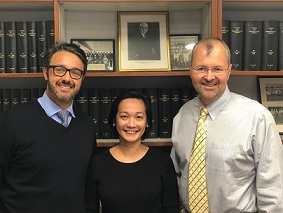Reconstructive Transplant Research
Biomarkers to Predict Rejection in Vascularized Composite Allotransplantation



Posted March 9, 2018
Leonardo Riella, M.D., Ph.D.; Bohdan Pomahac, M.D.; Brigham and Women's Hospital, Inc.

Face and extremity transplantation can transform the lives of individuals who have suffered from devastating wounds or significant loss of tissue from accidents or disease. Lost or severely injured tissues can be substituted with those from a tissue donor via vascularized composite allotransplantation (VCA). VCA procedures can successfully restore appearance and function when tissue injuries are irreparable using conventional reconstructive surgery, but transplantation is not without risk. To circumvent allograft rejection, recipients of VCA adhere to lifelong regimens of immunosuppression medications, which can lead to organ toxicities and conditions such as infections, metabolic disorders, and malignancies.
Drs. Leonardo Riella and Bohdan Pomahac from Brigham and Women's Hospital hypothesize that novel biomarkers of allograft rejection could allow for timelier clinical interventions and minimize the exposure of VCA recipients to anti-rejection medications. In addition, molecular biomarkers or tools may be able to distinguish between rejection states such as antibody-mediated rejection (ABMR) and T cell-mediated rejection (TCMR), which require different treatment strategies and are difficult to differentiate under conventional microscopy. The investigators are using cutting-edge techniques and a unique biobank of samples collected from face transplant recipients to identify potential biomarkers of rejection. Drs. Riella and Pomahac and their colleagues recently published a case study in which gene expression was compared in facial allograft biopsies collected from a VCA recipient during both rejection and absence of rejection. Seventy-nine genes were shown to be upregulated and one gene was downregulated during rejection episodes compared to non-rejection. These findings demonstrated an activation of the interferon-gamma pathway (including IRF1 and STAT1), as well as activation of the genes responsible for recruitment of cytotoxic cells or those with immune effector function. This gene expression pattern is consistent with the presence of inflammation during allograft rejection. The investigators further compared gene expression in biopsies collected during suspected ABMR and TCMR episodes to determine whether these rejection states have unique biomarker signatures. Using a principal component analysis, the investigators identified 31 genes that contributed most to the variability between ABMR and TCMR. Overexpression of genes associated with leukocyte-endothelial cell interactions (including ICAM1, VCAM1, and SELE) was observed during ABMR episodes, whereas genes associated with cytotoxicity (such as GZMB) were upregulated during TCMR. These gene expression patterns suggest that ABMR and TCMR may have different features. For instance, ABMR may be associated with a pro-inflammatory environment involving activation of the endothelium and recruitment of white blood cells to the allograft, whereas an increase in cell death-related signaling may be present during episodes of TCMR. Analysis of additional samples from VCA recipients will both further interpretation of these preliminary findings and validate potential biomarkers for allograft rejection.
These findings offer new insights into the mechanisms underlying VCA rejection and the prospective biomarkers that may be useful in guiding the clinical care of VCA recipients, such as adjustments in dose or selection of immunosuppression medications. The results also suggest that molecular diagnostic tools may complement existing clinical, serological, and histological examinations for the diagnosis of allograft rejection in the context of VCA. In future studies, the investigators will establish whether rejection biomarkers can also be detected through a non-invasive blood test. The frequency of rejection and complications of long-term immunosuppression are barriers to VCA, but this research will identify novel biomarkers that could lead to better monitoring and new therapeutic targets for treating rejection, which could maximize the quality of life for VCA recipients.

A heatmap showing the expression of 31 genes that contributed most to the variability between antibody-mediated rejection (ABMR) and T-cell mediated rejection (TCMR) in a face transplant recipient. Each column represents a facial allograft biopsy, with the bar along the top indicating whether each biopsy was collected during a suspected ABMR (light red) or TCMR (blue) episode. Each row of the heatmap illustrates whether the expression of a single gene was increased (red) or decreased (blue).
References:
Win TS, Murakami N, Borges TJ, Chandraker A, Murphy G, Lian C, Barrera V, Ho Sui S, Schoenfeld D, Teague J2 Bueno E, Tullius SG, Pomahac B, Clark RA, Riella LV. 2017. Longitudinal immunological characterization of the first presensitized recipient of a face transplant. JCI Insight 2(13):e93894.
Link:
Last updated Friday, December 13, 2024














